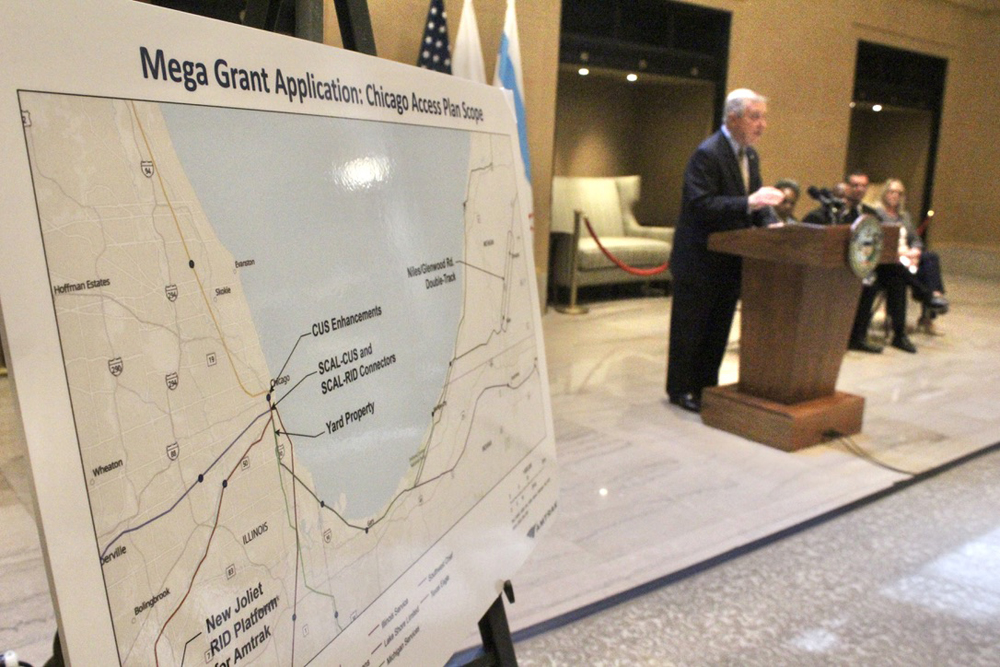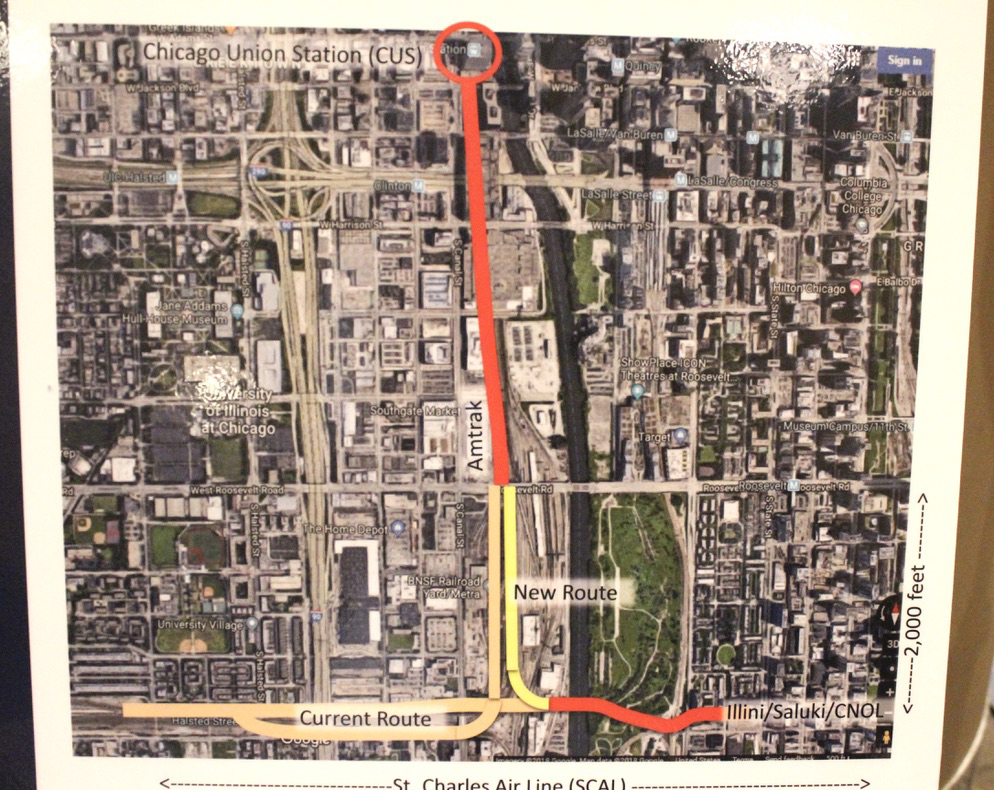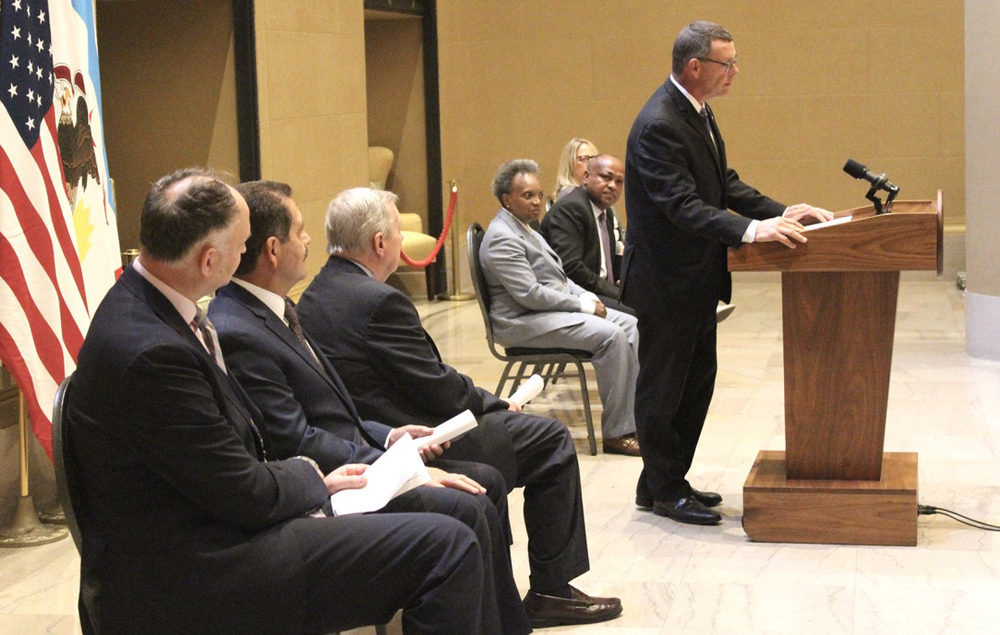
CHICAGO — Key contributors seeking $251.1 million from a federal competitive grant program focused on Chicago Union Station improvements at a Thursday event to announce their involvement.
U.S. Sen. Dick Durbin, Chicago Mayor Lori Lightfoot, Amtrak CEO Stephen Gardner, and Metra CEO/Executive Director Jim Derwinski were among the speakers at the station’s Burlington Room, explaining how the region will benefit if their bid for Infrastructure Investment and Jobs Act’s MEGA project funds is successful.
The plan was presented as “The Chicago Union Station Access Project,” even though many aspects address how Amtrak trains enter the Windy City from the south and east. There is also a component increasing capacity on the Chicago-Detroit Wolverine corridor [see “Amtrak unveils infrastructure plan to transform Chicago operations,” Trains News Wire, June 10, 2022].

Reactivating three now-idle Union Station platforms once used to load and unload mail will provide full-length level boarding for the first time, but a significant operational change involves building a ramp up to the St. Charles Air Line that would eliminate a back-up move for trains serving Carbondale, Ill., and New Orleans.
Derwinski and Lightfoot both credited Amtrak for taking the lead in formulating initiative details and coordinating efforts of stakeholders to provide the 50% match for the $418.5 million project.
Gardner said the company has been working with “an incredible coalition … to make this building the centerpoint for commerce, mobility, and culture in this city, connecting not only Illinois destinations but the entire Midwest. He added, “There’s no path to dealing with mobility challenges or the climate crisis without rail.”
Metra’s Derwinski said, “These partnerships, I believe, are exactly what this station needs to move forward.”
Durbin, who has held his Senate seat since 1997, said the project’s goal was obvious.
“We need to make sure we increase access to the station and improve on-time performance,” he said. “And if you’ve ever waited for an Amtrak train at the station — and I have many, many times — you know the mob scene before the train is boarded. We’re going to make it a positive experience [for passengers].”

Lightfoot stressed the importance of making it easier for people to travel to and from Chicago “without their cars. … Red states or blue states, Republicans or Democrats, transportation unifies us all in our region.”
The ramp to the St. Charles Air Line paves the way for direct service from O’Hare International Airport with a stop at Union Station to the McCormick Place Convention Center. Though Durbin referred to “the vision linking key elements of the Chicagoland area,” and that the station project would be “the center of that activity,” none of the participants suggested details of who would finish constructing or operate a O’Hare-McCormick Place service.
Rick Harnish, executive director of the Chicago-based High Speed Rail Alliance, floated the possibility of a “CrossRail Chicago” plan several years ago. He tells News Wire, “It’s a big step to have all of these leaders in the room supporting a grant that can get done quickly and within existing rail footprints.”
Harnish notes that other aspects of CrossRail, such as establishing a direct route into the airport and O’Hare station, or reconfiguring the complicated interlocking west of downtown at Western Avenue, would likely require separate environmental studies. “But approval of this grant application and construction would be a game-changer that sets the stage,” he says.














So many changes coming. I will miss 16th St Tower, the old SCAL infrastructure and the B&OCT bascule bridges. But passengers really need these improvements.
To get that ramp to the StCAL bridge built they will have to dispose of the former B&O Chicago River span once and for all.
There is one developer who wants to build out a very large set of high rises around McCormick Place, but for it to work he needs better transit options than is available today. The developer cannot get single ride access to O’Hare today from his plan and he proposes using the StCAL as the ticket. He doesn’t care if it is Metra, or Jim Bob’s Transit running that train, he knows that easy one seat/non xfer O’Hare access is key to selling his deal.
“Jim Bob’s Transit”. Love it. Great line Mr. Rice and so true. But hopefully it will be “My Metra”.
Anyone want to guess how Mr. Gardner traveled to CHI and back?
Wel, I was once on a train from Boston to Toledo with then Amtrak president Paul Reistrup. (I assume Reistrup continued on to Chicago, I don’t know after I got off at Toledo.) So if Garner is like Reistrup he took the train.
Ha-ha, Just kidding.
Paul Reistrup wanted a minimum of two trains per day on each route. Can the same be said if gardner?
You’re d**ned right you’re just kidding. You can’t put Paul Reistrup and Stephen Gardner in the same universe. Gardner wouldn’t make a pimple on Reistrup’s butt. But if Gardner flew, if he wouldn’t “go out in the field” say riding #29, 48/448, and his precious NEC, that should tell everyone in the passenger rail advocacy community, including but especially the folks at RPA, that he has zero respect for the LDs and is bound and determined to kill them. Go to CHI to talk up a growth strategy for passenger rail and not ride your own trains to get there and get back??? Disgracefully, the delusional Amtrak shills at RPA, even if they recognize what’s going on, will it publicly acknowledge it.
Gardner rode the Empire Builder once I’m told. All the way from Seattle to Everett when the train resumed daily operation last year.
“All the way from Seattle to Everett”. Wow! I think you reinforced my point.
Are any of these projects tied to CREATE?
No and that’s intriguing; it takes advantage of some CREATE projects. The former Rock Island diamonds at Englewood were replaced with a flyover. Under this plan trains to St. Louis and beyond via Joliet would now use that improvement.
Using the South Shore as a dedicated passenger main for east coast trains takes advantage of all of the upgrades completed and in progress.
And then keeping the St. Charles Air Line to access the former Illinois Central negates the need for the reconstruction of the connection of Grand Crossing.
All of this may actually SAVE money. What a concept!
DANIEL. Great post!
Fifty-one years into Amtrak someone finally comes up with some good ideas for Chicagoland south and east/
Which is why the skeptic in me wants to know: Why now?
Good question, Mr. Carleton. Maybe the $66b the Biden administration handed Amtrak was the spark? Regarding the CHI-STL trains, I think what’s being talked about is a reconfigured SCAL connection with the RID at the 16th crossing, not with a ramp connection at Englewood. Funny enough, one of my supervisors at the Metra CCF was strongly opposed to hosting Amtrak on the RID because that would leave Metra alone on the CN Joliet Sub and then the projects to address the choke points there that cause delays to Heritage Corridor trains would never get done. I guess, given the presence of Metra CEO Derwinski at this gathering, Metra has decided to embrace the plan. Another thing regarding operation over the RID is the matter of opposing trains meeting at stations. I’ve been retired from Metra for some 14 years and maybe the procedures have changed but it used to be that the train approaching could not enter the station until the train already there on the other main had cleared. (BNSF has no such restriction CHI-Aurora. By contrast, on the Milw lines the train in the station had to stay in the station blocking crosswalks and a member of the crew had to be stationed at the rear to prevent “walk arounds” until the opposing train got in. Regarding moving the Capitol and Lake Shore to the South Shore Line, gotta wonder what those folks think of it. Btw, at Hegewish, Hammond, and East Chicago there are gauntlet tracks on both mains that keep the freights away from the high-level platforms. The MAS for the passenger diverging routes is, from my few rides pre-pandemic, something like 15mph. Engineers were robbed of their ability to “drive” into those stations and wind on the brakes at or near the ends of platforms to make their stops. Very inefficient and robbing crews the ability to recover time if running late. I don’t know the MASs for the freight route but if they are considerably less than track speed, than surely that cannot be good for Amtrak operations.
One more: If the South Shore extension to Munster/Dyer is built that is a direct connection to the former Monon for the Cardinal. More mileage off the CN.
Am I reading this right? The whole thing for $418.5 million?
As in my post above yours, we’re left to wonder.
I don’t know if it’s hasty writing by TRAINS MAGAZINE, or if the fault lies with the officials in their smile-face dog and pony show, but there’s a lot missing.
Obviously, we’re early in the game. Even so, the job of a journalist is to ask for follow-up information in writing.
Is it me or did this proposal come rather quickly out of left field? Everything up until now was centered around CREATE and its panoply of plans for grade separations, added crossovers and freight/passenger corridor improvements. There is a dose, however so small, of pragmatism here.
No question we now have a vision and are headed in the right direction. That’s a change!
Missing from the article is a timeline and a total cost for these projects. Exactly how far does this “Mega Grant” take us in relation to the needed improvements as a whole? What’s the next step? When does all this happen? How far will this grant take us into Indiana where major projects are also needed.
Hopefully this will happen. Fifty-one years into Amtrak the last thing we need is more proposals or studies — or more photo ops for the Senator and Mayor.